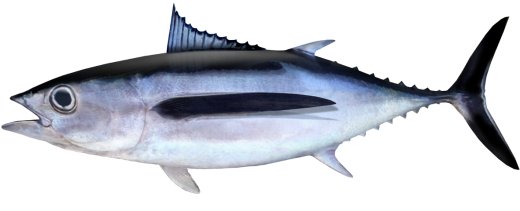Albacore

Common Name: Albacore
Scientific Name: Thunnus Alalunga
Albacore is very low in sodium and is a very good source of protein, vitamin A, vitamin B12, selenium, and niacin. For more on nutrition, see Nutrition Facts. Albacore are widely distributed throughout the world's marine ecosystems in tropical, sub-tropical, and temperate zones of the Pacific, Atlantic, and Indian Oceans. In the Pacific Ocean, it is generally believed that there exists two stocks of albacore, one in the North Pacific hemisphere and one in the South Pacific hemisphere. Available data indicate that the two stocks do not cross the equator and have separate spawning grounds and times.
Diet
Albacore feed on fish, crustaceans, and squid.
Behaviour
Today's albacore tuna are highly advanced marine teleosts, or bony fish, whose earliest ancestors are generally believed to have emerged during the Mesozoic Era, roughly 65 to 210 million years ago. Albacore are members of the Scombridae family, which includes 40 to 50 species of tuna and mackerel, 23 of which are found, for at least a part of their life, in waters off the coast of North America.
Life History
Albacore are a highly migratory species. Schools of albacore may include other tuna species such as skipjack, yellowfin, and bluefin tuna. Males live longer than females in the Atlantic and Mediterranean. The maximum lifespan of albacore in the Atlantic is 13 years, while it is only 9 years in the Mediterranean.
Habitat
Albacore is a temperate tuna. Juveniles are mainly found in warmer surface waters, while adults are found in cooler and deeper waters.
Special Features or Habits
Albacore have very small scales on their body. Their pectoral fins are remarkably long, about 30% of fork length or longer in 1.6 feet or longer fish.
Location or Region Found
In subtropical western areas of both hemispheres and throughout the Mediterranean Sea.
 Deep Sea Crabs
Deep Sea Crabs